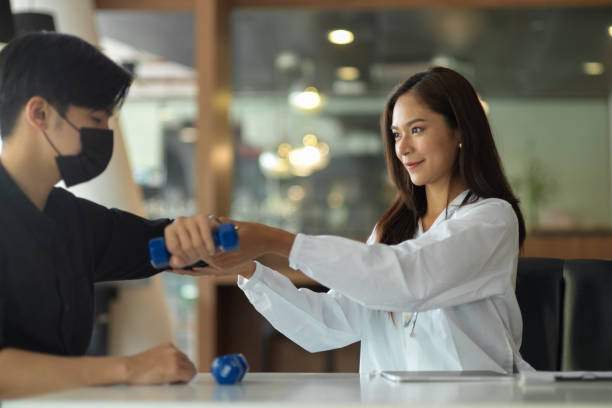Physiotherapy is a treatment that addresses injuries and illnesses that impact the body. It is often paired with other treatments, such as hydrotherapy and manual therapy.
Embracing empowerment is central to community psychology research, and several studies in the AJCP explore barriers and facilitators of disability-related empowerment. These include individual-level barriers and awareness behaviors (e.g., critical awareness of disability rights).

Physiotherapy
Physiotherapy is a health care profession that helps people with injuries and illnesses. It involves movement and exercise, manual therapy and education. It is a patient-centered approach that maximizes physical potential, taking into account the person’s overall lifestyle.
Disability impacts not only a person’s physical well-being, but also their mental and social well-being. Living with a disability can be stressful, and it is important for individuals to have a sense of self-worth and feel supported by those around them. Physiotherapy can help with this by encouraging self-growth and supporting positive mindsets.
People with disabilities often face stereotypes and discrimination. They are sometimes misunderstood, or they may feel like they have no one to talk to. Getting to know someone with a disability and being there for them as they work towards their goals is an act of kindness that will make them feel empowered and loved.
In addition, physiotherapy Watsonia can include techniques like soft tissue mobilization, which involves applying controlled pressure, stretching or kneading to muscles, tendons, ligaments, and fascia to relieve pain, increase flexibility, break up scar tissue, and promote healing. This type of treatment can also address respiratory issues, such as asthma and chronic coughing. These techniques can improve a person’s breathing and energy levels, which can also boost their emotional well-being. Lastly, physiotherapists can help to alleviate pain through various non-invasive methods, including therapeutic exercises, manual therapy, heat/cold therapy and electrotherapy.
Manual Therapy
Manual Therapy is a group of hands-on techniques used by physical therapists to treat pain and improve range of motion. It can include a number of techniques, such as soft tissue massage, mobilization and manipulation. These techniques use varying amounts of force and speed to help align and reposition the body’s bones, muscles and ligaments.
A physical therapist can use manual therapy to improve muscle mobility, break down scar tissue and reduce pain. It can also help decrease swelling in the body. This type of treatment is not used for all patients, and it’s important to find a physical therapist who has training in this area.
Physical therapists, especially physiotherapist Ivanhoe, who specialize in manual therapy have undergone extensive education and training. They also receive continuing education to keep their skills sharp. Many insurance companies limit coverage for manual therapy, so it’s important to find a provider that accepts your specific plan
Manual therapy is a centuries-old technique. It is performed primarily by osteopathic physicians, chiropractors and physical therapists to relieve pain and improve function. It is classified as joint-biased, muscle and connective tissue-biased or neurovascular-biased based on the primary focus of the techniques used. The effectiveness of MT is limited by interpractitioner reliability and by psychosocial factors that influence response to the intervention, including expectations, therapeutic alliance and catastrophizing.

Hydrotherapy
The warm, refreshing water of a swimming pool can be therapeutic for people of all ages. It soothes muscles, reduces pain and swelling, helps the body heal, and relieves stress and anxiety. It can also boost circulation, which may help those with arthritis or muscle injuries. Moreover, it promotes mobility and increases balance and coordination, thereby improving quality of life.
In hydrotherapy, clients are submerged in a therapeutic pool and perform exercises that mimic their daily activities. These movements are performed under the guidance of a physical therapist. The physiotherapist incorporates the unique properties of water, including decreased gravity, buoyancy, hydrostatic pressure and viscosity to enhance healing and provide a safe environment for rehabilitation and exercise.
Individuals with profound and multiple learning disabilities (PMLD) often have complex health needs, making them vulnerable to physical injury or illness. However, a well-planned and delivered programme of hydrotherapy can be highly effective for PMLD individuals.
Using a therapy pool for hydrotherapy can improve the independence of an individual. It can also encourage social interaction and improve their quality of life. Furthermore, participating in group sessions and exercising alongside peers can build confidence and increase their sense of community. As such, hydrotherapy is a crucial means of empowerment for individuals with disabilities. It gives them an opportunity to build skills that they can use outside the pool and in their everyday lives.
Art Therapy
Art therapy is a form of expressive therapy which uses visual arts to help individuals with disabilities express themselves creatively, boost their self-esteem and develop a variety of skills. It also helps them explore new interests and discover their passions, while enhancing communication skills and promoting social interactions. This holistic approach can be beneficial for those who suffer from developmental disabilities, including autism and PTSD.
Several studies have shown that art therapy can help reduce depression and anxiety, and improve overall mental health. In addition, it can help control symptoms of conditions such as schizophrenia, bipolar disorder, and dementia, and increase quality of life.
In addition, art therapy can enhance fine motor skills and improve hand-eye coordination. It can also stimulate emotional and energetic expression, which is especially helpful for individuals with developmental disabilities. It is also an excellent way to relieve stress and anxiety, as it provides a fun, relaxing activity.
Art therapy can take place in an individual or group setting. Individual sessions allow clients to establish a trusting relationship with their clinician, learn about privacy and confidentiality, and practice essential communication skills. Group sessions offer a safe space for individuals to connect with one another and develop mutual support networks. These connections can help them foster meaningful relationships, improve their ability to manage their emotions and cope with challenging situations.

 April 15th, 2024
April 15th, 2024  adminva2
adminva2 
































 What Causes Shoulder Pain?
What Causes Shoulder Pain?